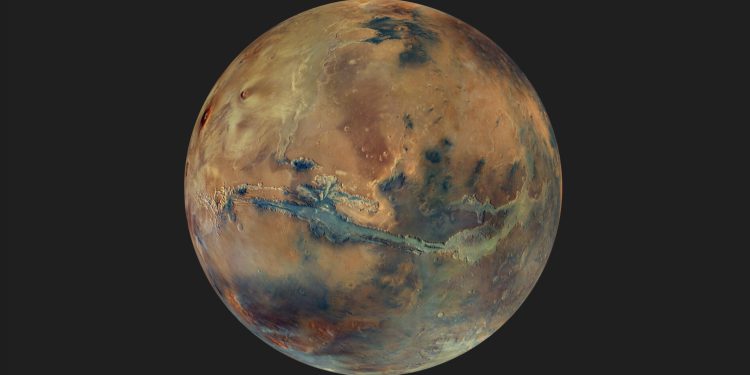A recent study by researchers from the Swedish Institute of Space Physics (IRF) in Kiruna, in collaboration with Umeå University, has uncovered a surprising interaction between Mars and the solar wind. The findings, published in Nature, reveal that under specific conditions, Mars’ induced magnetosphere can break down, leading to significant consequences for the planet’s atmosphere.
Unlike Earth, which has a strong internal magnetic field that acts like an invisible shield, Mars is exposed to the harshness of space without such protection. Earth’s magnetic field deflects much of the solar wind—a stream of charged particles constantly flowing from the Sun—preventing it from stripping away our atmosphere. In contrast, Mars has to rely on what’s called an induced magnetosphere. This happens when the planet’s atmosphere directly interacts with the solar wind, creating a weak magnetic barrier.
The solar wind is not just a simple gust of particles; it carries its own magnetic field, and when this magnetic field collides with Mars, it sets off a delicate balance. Think of it as a cosmic tug-of-war, with the solar wind pulling at Mars’ atmosphere, and the induced magnetosphere acting as a temporary defense. However, this defense is not nearly as strong or effective as Earth’s internal magnetic shield. As a result, much of Mars’ atmosphere has been lost over time, contributing to its transformation into the cold, dry planet we see today. This interaction between the solar wind and Mars’ atmosphere plays a critical role in determining how much atmosphere is able to cling to the planet and how much is gradually swept away into space. Understanding this process is key to uncovering how Mars evolved and what its future might hold, especially as we explore the possibility of human missions to the Red Planet
A Surprising Discovery
Researchers utilized both advanced computer simulations and data collected by scientific instruments onboard two spacecraft—ESA’s Mars Express and NASA’s MAVEN—to study this phenomenon. A critical tool in these observations is the Analyzer of Space Plasmas and Energetic Atoms (ASPERA-3), developed by the IRF. This instrument, which has been orbiting Mars for over 20 years, has continuously monitored ions, electrons, and neutral atoms in the planet’s vicinity.
The team found that when the solar wind’s protons align with the magnetic field embedded within the solar wind, Mars’ induced magnetosphere weakens significantly. “Such a degenerate magnetosphere allows for a greater loss of atmospheric particles into space,” explains Qi Zhang, a Ph.D. student at the IRF and Umeå University, and the study’s lead author. This loss has profound implications for Mars’ ability to retain an atmosphere—critical to understanding the planet’s past climate and its potential for habitability.

ASPERA-3 has been a key player in these discoveries, providing over two decades of invaluable data. Its measurements of ion outflows have allowed scientists to track how Mars’ atmosphere has been slowly eroding. The instrument’s long-term observations offer a glimpse into how solar wind conditions can affect the planet’s atmospheric loss, potentially altering our understanding of its evolution.
Implications for Future Mars Exploration
The study’s findings not only shed light on Mars’ atmospheric history but also offer critical insights for future exploration missions. As agencies like NASA and ESA plan more manned and unmanned missions to the Red Planet, understanding how Mars interacts with solar wind is key to anticipating environmental challenges that may arise. This knowledge is particularly relevant for human exploration, as astronauts and equipment will need protection from the Sun’s unrelenting charged particles.
These results feed into a larger narrative about planetary magnetospheres and their role in preserving atmospheres. On Earth, our magnetic field shields us from solar radiation and protects our atmosphere from being stripped away. Mars, without such a defense, has seen its atmosphere thin over millions of years. This process likely played a role in the planet’s transformation from a once warmer, wetter world to the cold, dry desert we see today.
Looking ahead, further research is needed to explore how these interactions might evolve with changes in solar activity. Will periods of intense solar storms accelerate atmospheric loss on Mars? Could this explain some of the planet’s more drastic climate shifts in the past? These are the questions that researchers like Zhang and her team are eager to answer.
As scientists continue to unravel the mysteries of Mars’ atmosphere, there is a growing sense of excitement. Each new discovery not only brings us closer to understanding the Red Planet but also opens the door to fresh possibilities for future exploration and perhaps, one day, even habitation. With upcoming missions from agencies worldwide, Mars’ story is far from over.











